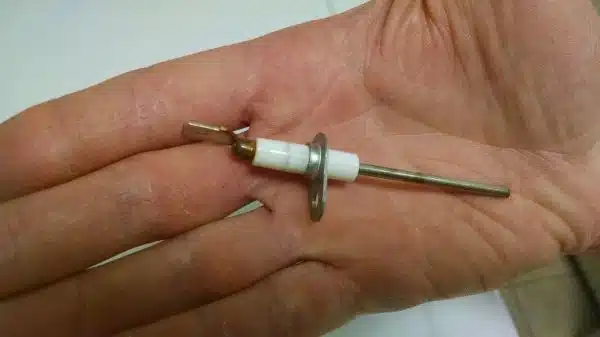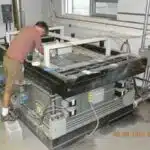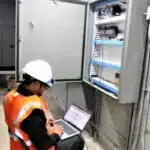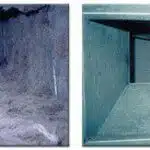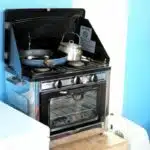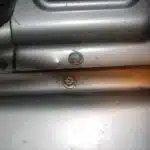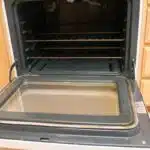Maintaining the proper functionality of a furnace is crucial, especially during the winter months. A furnace flame sensor is an essential component that helps ensure that your heating system works efficiently and safely. Over time, this sensor may get dirty or covered with soot, which can cause it to malfunction and potentially shut down the entire system. As an HVAC technician, it is important to know how to clean a furnace flame sensor properly.
Cleaning a furnace flame sensor involves removing any dirt or debris that may have accumulated on its surface. This process requires some technical know-how and expertise to ensure that you do not damage the sensor while cleaning it. In this article, we will discuss the steps you need to take to clean a furnace flame sensor effectively. Whether you are an HVAC technician or a homeowner looking to maintain your heating system, understanding how to clean this essential component will help keep your home warm and comfortable during those cold winter days.
Understanding The Importance Of Furnace Maintenance
As a HVAC technician, I cannot stress enough the importance of regular furnace check ups. Neglecting your furnace can lead to costly repairs and even dangerous situations such as carbon monoxide leaks. One should be proactive when it comes to maintaining their furnace, rather than reactive.
DIY furnace maintenance tips are simple and easy to follow. The first step is to ensure that the air filter is clean; this allows for proper air flow through the furnace. Another important aspect of DIY maintenance is keeping the blower motor lubricated. Over time, lack of lubrication can cause the motor to overheat and eventually fail.
Regular maintenance not only increases the lifespan of your furnace but also ensures that it is running efficiently, which in turn saves money on energy bills. Signs of a dirty or malfunctioning flame sensor include intermittent heat cycles and frequent system shut downs. It is important to address these issues as soon as possible to avoid further complications.
Signs Of A Dirty Or Malfunctioning Flame Sensor
A dirty or malfunctioning flame sensor is a common issue that HVAC technicians encounter on a regular basis. If left unchecked, it can lead to problems such as the furnace not heating up or even worse, gas leaks. Therefore, it is crucial to know the signs of a dirty or malfunctioning flame sensor so you can troubleshoot and fix the problem before it becomes more serious.
One of the most noticeable signs of a dirty or malfunctioning flame sensor is when your furnace starts to act up and seems to be having trouble igniting. This could be due to a buildup of dirt and debris on the sensor itself, which prevents it from detecting the flame properly. Another sign is if your furnace turns off unexpectedly after starting up, which may indicate that the sensor has failed altogether.
Other signs include flickering flames that are inconsistent in their height or color, as well as unusual noises coming from the furnace itself. If you notice any of these symptoms, it’s important to act quickly and address them before they become more serious. Checking for gas leaks should also be done regularly during troubleshooting ignition problems.
To avoid potential safety hazards and ensure your furnace runs smoothly, make sure you stay on top of routine maintenance tasks such as cleaning your flame sensor regularly. In the next section, we will go over some tools and materials needed for cleaning so you can get started right away and keep your furnace in top shape.
Tools And Materials Needed For Cleaning
As a HVAC technician, it is essential to emphasize the importance of regular furnace maintenance. One of the critical components of proper furnace maintenance is cleaning the flame sensor. By cleaning the flame sensor, you can avoid costly repairs and ensure that your furnace operates efficiently.
Before diving into the steps to clean a furnace flame sensor, it is crucial to troubleshoot a malfunctioning furnace. If your furnace is not producing heat or not functioning correctly, there could be various reasons why this issue is occurring. It could be an issue with the thermostat, filter, gas supply, or even a problem with the flame sensor itself.
To clean a furnace flame sensor effectively, you will need several tools and materials. These include a screwdriver (if necessary), emery cloth or sandpaper (to remove any debris), and rubbing alcohol (to clean the surface thoroughly). Once you have these materials ready, you can begin cleaning your furnace’s flame sensor.
It’s essential to turn off the furnace before cleaning it to prevent any accidents or injuries. By taking this precautionary step and following these simple instructions for cleaning your furnace’s flame sensor, you can ensure that your system runs smoothly and efficiently throughout its lifespan.
Turning Off The Furnace Before Cleaning
Before attempting to clean the furnace flame sensor, it is crucial to turn off the furnace completely. This step is essential because if the furnace remains on during cleaning, it can pose a significant risk to those performing the task. Additionally, it can result in damaging the furnace or even injuring someone. Therefore, it is imperative to turn off the power source before proceeding with any maintenance work.
Safety precautions are critical when cleaning a furnace flame sensor. Always make sure that you wear protective gloves and goggles before beginning work. The gloves will protect your hands from getting burned or cut while handling hot parts of the furnace, while goggles will safeguard your eyes from debris or dust particles that may fly into them during cleaning. Also, ensure that you use a flashlight to help you see better as you work.
Cleaning a furnace flame sensor should be done with utmost care and caution. As such, after turning off the power source, wait for at least 30 minutes before starting any cleaning process. This waiting period allows ample time for all components of the furnace to cool down. After waiting for this period, remove the door panel of your furnace and locate its flame sensor – which is usually located near its burner assembly- then proceed with removing it carefully.
Without disturbing its wiring connections, gently remove the flame sensor by unscrewing it using a screwdriver and place it on a clean surface for inspection and cleaning.
Removing The Flame Sensor
To remove the furnace flame sensor, you must first locate it. It is typically located near the burner assembly, and it looks like a thin, metal rod with a wire attached to it. Turn off the power supply to your furnace before attempting to remove the flame sensor.
Once you have located the flame sensor, gently pull it out of its position. Be careful not to damage any wires or connectors that may be attached to it. Inspect the sensor for any signs of wear and tear or damage. If there are any issues found here, refer to the troubleshooting tips mentioned below.
DIY cleaning is possible if you have experience working with HVAC equipment. However, if you are not confident in doing this yourself, it’s best to contact a professional technician for cleaning services. Common issues such as dirt buildup and corrosion can cause problems with the sensor’s ability to detect flames properly. Cleaning the sensor can help resolve these issues and restore proper operation of your furnace.
Inspecting the sensor for damage is an essential step in maintaining your furnace’s optimal performance levels. In the next section, we will go over how to do this effectively and efficiently without causing harm or further damage to your unit.
Inspecting The Sensor For Damage
To ensure that your furnace is working efficiently, it is important to check the flame sensor for possible damage. One of the most common issues with a flame sensor is corrosion buildup on its surface. Corrosion can prevent the sensor from working properly, which may cause the furnace to shut down unexpectedly. To check for corrosion, you will need to remove the sensor and inspect it closely.
When inspecting the flame sensor, use a flashlight to look for signs of rust or corrosion on its surface. Check that there are no cracks or other visible damage as well. If you notice any signs of wear and tear, you may need to replace the sensor altogether. However, if there is only minor corrosion buildup, you can clean it off using a fine-grit sandpaper or steel wool.
Troubleshooting common issues with your furnace’s flame sensor can save you time and money in repairs down the road. In addition to checking for corrosion, make sure that all wiring connections are secure and free from any debris or damage. A dirty air filter can also cause issues with your furnace’s performance, so be sure to replace it regularly. By following these steps, you can help keep your furnace running smoothly all winter long.
To prepare the flame sensor for cleaning, gather all necessary tools and materials such as sandpaper or steel wool, a soft-bristled brush, and a clean cloth. Make sure that you have turned off power supply to the furnace before removing anything from it. Once removed from the furnace assembly unit, gently clean the surface of the flame sensor with either sandpaper or steel wool until all visible corrosion has been removed.
Preparing The Sensor For Cleaning
- The power to the furnace must be shut off before attempting to remove the sensor from the furnace.
- The sensor should be removed from the furnace by unscrewing the mounting screws and disconnecting the wiring connections.
- To ensure a safe removal, any exposed wire connections should be insulated.
- Once the sensor is removed, the connections should be cleaned with an approved chemical solution.
- During the cleaning, care must be taken to ensure that no chemical residue is left on the connections.
- After the connections have been cleaned, they should be inspected to ensure that they are free of corrosion.
Shut Off Power
It is crucial to shut off the power before preparing the furnace flame sensor for cleaning. The importance of regular furnace maintenance cannot be stressed enough in ensuring the optimal performance and longevity of your furnace. Shutting off the power supply ensures that electricity does not flow through the sensor while you work, reducing the risk of electrical shock.
As a HVAC technician, safety precautions when working with electrical equipment are paramount. Before shutting off the power supply, it is imperative to identify which circuit breaker or fuse controls the furnace and turn it off accordingly. Additionally, it is advisable to use a voltage tester to confirm that there is no electricity flowing through the system before starting any work.
It is essential to prioritize safety when performing any task involving electrical equipment. Therefore, shutting off the power supply before cleaning your furnace flame sensor cannot be overemphasized. Failure to do so could result in serious injury or even death. As such, always remember to follow recommended safety protocols when maintaining your furnace or any other electrical equipment in your home or workplace.
Remove Sensor From Furnace
To ensure that your furnace operates at peak performance, regular maintenance is essential. One aspect of maintaining your furnace is cleaning the flame sensor. However, before you begin cleaning the sensor, it is crucial to shut off the power supply and identify which circuit breaker or fuse controls the furnace. As a HVAC technician, safety should always be the top priority when working with electrical equipment.
Once you have turned off the power supply, you can safely remove the sensor from your furnace. The first step in removing the sensor is to locate it within your furnace assembly carefully. You may need to refer to your owner’s manual or consult a professional technician if you’re unsure of its location. Once you’ve found it, use proper tools to gently disconnect it from its housing unit without damaging any other components.
When handling the sensor during cleaning, it is essential to exercise caution and avoid touching any sensitive parts with bare hands as this can damage them. Use a soft-bristled brush or compressed air to clean away any dirt or debris collected on it. Avoid using water or other liquids as they may cause corrosion or disrupt its functionality. Finally, once cleaned, replace the sensor into its housing unit and turn on the power supply to test if everything works correctly. Remember always to prioritize safety when working with electrical equipment!
Clean Sensor Connections
In addition to cleaning the sensor itself, it is also crucial to clean the sensor connections. Over time, corrosion can build up on these connections, leading to poor communication between the sensor and the furnace’s control board. This can result in intermittent or complete failures of the furnace system. As a HVAC technician, it is essential to know how to properly clean these connections.
To begin cleaning the sensor connections, first, turn off the power supply and identify which circuit breaker or fuse controls the furnace. Next, locate the sensor connections on both ends of the cable connecting it to the control board. Use a small wire brush or sandpaper to gently remove any corrosion present on these connections. Be sure not to apply too much force as this may damage the connectors.
If you encounter issues with your furnace despite cleaning both the flame sensor and its connections, further troubleshooting may be necessary. Some common troubleshooting tips include checking for loose wires or damaged components within your furnace assembly and ensuring that your thermostat is set correctly. If you are unable to solve these issues yourself, consult a professional HVAC technician as they have specialized knowledge and tools required to diagnose and repair complex problems effectively.
Cleaning The Sensor With A Soft Brush
Like a painter needs to maintain a clean brush to produce a masterpiece, an HVAC technician must ensure that the furnace’s flame sensor is free of debris and buildup. Using a soft-bristled brush, such as a toothbrush or paintbrush, can be an effective way to clean the sensor without causing any damage.
It’s crucial to emphasize the importance of regular sensor cleaning to prevent performance issues and potential safety hazards. A dirty flame sensor can cause the furnace to shut off prematurely or not ignite at all, leading to costly repairs and even dangerous gas leaks. Scheduling routine maintenance with a professional technician is recommended for optimal functionality.
For those who may not have access to a soft brush, there are alternative methods available. Some technicians use compressed air or vacuums with attachments specifically designed for cleaning sensors. However, it’s essential to exercise caution when using these tools as they can potentially cause damage if misused. Always consult with a professional before attempting any DIY cleaning methods.
Transition: While using a soft brush is typically sufficient for most buildup on the flame sensor, in some cases more stubborn debris may require additional measures such as using sandpaper or emery cloth.
Using Sandpaper Or Emery Cloth For Stubborn Buildup
When dealing with stubborn buildup on a furnace flame sensor, using sandpaper or emery cloth can be a viable solution. However, caution is necessary when using these abrasive materials, as they can damage the sensor if not used properly. The following tips will help ensure that your cleaning process goes smoothly:
- Use a fine-grit sandpaper or emery cloth to avoid scratching or damaging the sensor.
- Be gentle when scrubbing the sensor to avoid bending or breaking it.
- Clean the sensor in a well-lit area so that you can see what you’re doing.
- Wear gloves and protective eyewear to prevent injury.
- Avoid touching the actual sensing area of the sensor.
If using sandpaper or emery cloth does not remove all of the buildup on your furnace flame sensor, there are alternative cleaning methods available. One effective method is to soak the sensor in a vinegar solution for several hours before gently wiping it clean with a soft cloth. This method is especially useful for removing mineral buildup caused by hard water.
It’s important to note that frequent cleaning of your furnace flame sensor can help prevent buildup from occurring in the first place. Common causes of buildup include dust, dirt, and pollen, as well as mineral deposits from hard water. By keeping your furnace clean and well-maintained, you can extend its lifespan and reduce the risk of breakdowns.
Transitioning into the subsequent section about avoiding harsh chemicals or abrasives: While using sandpaper or emery cloth can be an effective way to clean your furnace flame sensor, it’s important to be careful when working with these abrasive materials. In the next section, we’ll discuss alternative methods for cleaning your sensor without resorting to harsh chemicals or abrasives.
Avoiding Harsh Chemicals Or Abrasives
Using harsh chemicals or abrasives to clean your furnace flame sensor can cause irreparable damage. Instead, it is recommended that you use eco-friendly cleaning products and DIY cleaning methods. These are not only safe for the environment but also safer for you and your family.
Eco-friendly cleaning products are a great alternative to traditional chemical cleaners. They are non-toxic, biodegradable, and do not harm the environment. You can easily find these products online or at your local hardware store. Simply apply the product to a soft cloth and gently wipe the sensor until it is clean.
DIY cleaning methods are also an effective way to clean your furnace flame sensor without using harsh chemicals or abrasives. For example, you can use a mixture of water and vinegar to create a natural cleaning solution. Apply this solution to a soft cloth and gently wipe the sensor until it is clean. This method is both safe for the environment and cost-effective.
Now that you have cleaned your furnace flame sensor using eco-friendly cleaning products or DIY cleaning methods, it’s time to reinstall the sensor back into its original position. This will ensure that your furnace continues to operate efficiently and effectively. To do this, simply follow the manufacturer’s instructions for reinstallation. Remember to be gentle with the sensor as it is fragile and can easily be damaged if mishandled.
Reinstalling The Sensor
Isn’t it funny how easily an important component like the furnace flame sensor can be removed and cleaned, but when it comes to reinstallation, many homeowners seem to struggle? Proper reinstallation of the furnace flame sensor is crucial for the furnace to function efficiently. As a HVAC technician, I have seen countless homeowners make common mistakes while reinstalling the sensor, which ultimately leads to a malfunctioning furnace.
To start with proper reinstallation, ensure that the sensor is placed back in its original position. It should be snugly fitted into the mounting bracket and secured with screws or clips. The wiring connected to the sensor should also be properly reconnected. Take extra care not to damage any wires as this may cause electrical problems later on.
Common mistakes that homeowners make include overtightening or undertightening screws or clips, which can damage both the sensor and mounting bracket. Another mistake is misaligning the sensor or installing it upside down. These errors can lead to incorrect readings by the control board and eventually cause more costly repairs if left unchecked.
- Here are some tips that you can follow when reinstalling your furnace flame sensor:
- Clean any debris from the mounting bracket before inserting the sensor.
- Use a torque screwdriver for precise tightening of screws or clips.
- Double-check wiring connections before turning on power to avoid short circuits.
- If your furnace uses an igniter rod instead of a flame sensor, carefully secure it in place without bending it.
- Always refer to your furnace manual for specific instructions on proper reinstallation.
Now that you have successfully reinstalled your furnace flame sensor (or igniter rod), it’s time to test your furnace after cleaning. It is recommended that you turn on your system and allow it to run for at least five minutes before checking if everything works correctly. A functioning flame sensor will provide consistent readings that indicate stable flames during operation. If you notice any issues like intermittent shutdowns or unusual noises, it’s best to call a professional technician to diagnose the problem. Remember, proper reinstallation of the furnace flame sensor is crucial for your furnace’s optimal performance.
Testing The Furnace After Cleaning
Once the furnace flame sensor has been cleaned, it is important to test the efficiency of the furnace to ensure that it is working optimally. A common way to do this is by checking the temperature of air coming out of the vents. If it is not warm enough or there are issues with airflow, further troubleshooting may be necessary.
It is important to note that even after cleaning the flame sensor and testing furnace efficiency, there are still common issues that homeowners may encounter with their furnaces. These include issues with ignition, thermostat malfunctions, and air filter problems. It is essential to troubleshoot these issues as soon as possible to avoid further damage to the system.
If homeowners are unsure about how to troubleshoot common furnace issues or feel uncomfortable doing so themselves, it is always best to call a professional for assistance. HVAC technicians are trained in identifying and fixing furnace problems quickly and safely. Waiting too long before calling for professional help can lead to more significant problems down the line, which can be costly and time-consuming to fix.
When To Call A Professional For Assistance
After cleaning the furnace flame sensor, it is important to test the furnace to ensure that everything is working properly. Turn on your furnace and observe the flame. If the flame ignites quickly and stays consistently blue, then your furnace is working correctly. If not, then you may need to repeat the cleaning process or call a professional for assistance.
When it comes to maintaining your furnace, there are some DIY troubleshooting techniques you can try before calling a professional. For example, if your furnace isn’t heating properly, check to make sure that all vents and registers are open and unobstructed. Additionally, check the air filter and replace it if necessary. These simple actions can often solve minor issues with your furnace.
However, there are times when calling a professional for assistance is necessary. If you smell gas or notice any other potentially hazardous situations while troubleshooting your furnace, immediately turn off your system and call for help. Additionally, if after trying DIY techniques your furnace still isn’t functioning properly or you’re unsure about how to proceed with repairs, it’s best to consult with a trained HVAC technician who can diagnose and repair any issues safely and efficiently.
Routine maintenance tips for your furnace include regular filter changes every 1-3 months, checking for air leaks in ductwork and sealing them as needed, cleaning the blower assembly once a year, and scheduling annual tune-ups with an HVAC professional. By following these tips and knowing when to call a professional for assistance, you can keep your furnace running smoothly all winter long.
Routine Maintenance Tips For Your Furnace
As an HVAC technician, I have seen firsthand the consequences of neglecting regular furnace maintenance. A neglected furnace can lead to a host of problems, including decreased energy efficiency, increased utility bills, and even safety hazards. Regular furnace maintenance is not only important for ensuring optimal performance but also for prolonging the lifespan of your heating system.
Luckily, there are several DIY furnace maintenance tips that homeowners can follow to keep their furnaces in top condition. One of the most important tasks is regularly changing or cleaning the air filter. A dirty air filter can cause your furnace to work harder than necessary and lead to increased energy consumption. Additionally, cleaning the furnace flame sensor can improve its performance and prevent it from malfunctioning.
By performing routine maintenance on your furnace, you can ensure safe and efficient heating for your home. Neglecting regular maintenance can result in costly repairs or even the need for a full replacement of your heating system. As a homeowner, taking proactive steps towards maintaining your furnace will not only save you money but also provide peace of mind knowing that your family is safe and warm during the cold winter months.
Ensuring Safe And Efficient Heating For Your Home
As an HVAC technician, it is crucial to prioritize heating safety when maintaining furnaces. One of the most important aspects of ensuring heating safety is regularly cleaning the furnace flame sensor. Neglecting to clean this component can lead to a malfunctioning furnace that poses a significant fire hazard. Therefore, homeowners should schedule regular maintenance with qualified technicians who will inspect and clean their furnace flame sensors.
Efficient heating techniques are also key to ensuring home heating safety. Proper ventilation and insulation can significantly reduce energy consumption while keeping your home warm during cold weather. Additionally, replacing old furnaces with newer models that have high AFUE ratings helps reduce overall energy costs while providing efficient heating. By implementing these measures, homeowners can ensure that their homes remain cozy and safe throughout the winter season.
In conclusion, maintaining proper heating safety and efficiency is essential for every homeowner. Regular cleaning of furnace parts such as the flame sensor, along with proper insulation and ventilation, can help prevent fires while reducing energy consumption. By working with qualified technicians and adopting efficient heating techniques, homeowners can keep their homes warm and safe during colder months without breaking the bank on energy bills.
Conclusion
Furnace maintenance is crucial to ensure safe and efficient heating for your home. A dirty or malfunctioning flame sensor can cause your furnace to shut down, leading to discomfort and potential safety hazards. By understanding the importance of furnace maintenance and recognizing the signs of a dirty flame sensor, you can take steps to keep your furnace functioning properly.
To clean a furnace flame sensor, you will need specific tools and materials, including a screwdriver, fine-grit sandpaper, and a soft cloth. It’s essential to turn off the furnace before removing the flame sensor and testing it after cleaning. If you’re unsure about performing these tasks yourself, it’s best to call a professional for assistance.
Routine maintenance of your furnace can help prevent issues like a dirty flame sensor from occurring. Changing air filters regularly, keeping the area around your furnace clear of clutter, and scheduling annual inspections are all important steps in maintaining your furnace’s efficiency and safety.
In conclusion, as an HVAC technician, I cannot emphasize enough how vital it is to keep your furnace in good working condition. Neglecting routine maintenance can lead to serious problems that may compromise the safety of your home. By taking simple steps like cleaning the flame sensor regularly and scheduling annual inspections with a professional technician, you can ensure that your furnace provides reliable warmth throughout the winter months. So don’t hesitate – give your furnace the attention it deserves today!
Image Credits
- “Furnace flame sensor” by MarkDoliner (featured)

